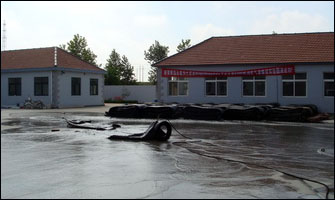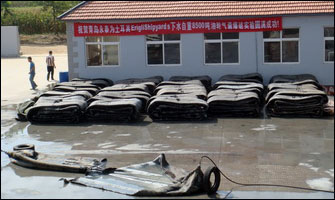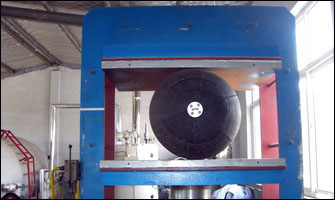Eversafe Marine executes most strict quality control method to ensure clients’ 100 percent satisfaction of our products. Based on ISO9001-2000 quality system. Eversafe gets precise control techniques for the whole production chain.
The main standards we followed for ship launching airbags are ISO 14409: 2011 and CB/T 3795-1996.
Rubber Material Test
|
Test item
|
Test method
|
Required valuve
|
|
|
Out rubber
|
Inner rubber
|
||
|
1. Before ageing
|
---
|
---
|
---
|
|
1.1Tensile strength
|
ISO 37:1994
|
18 MPa or more
|
10MPa or more
|
|
1.2 Elongation
|
ISO 37:1994
|
400% or more
|
400% or more
|
|
1.3 Hardness
|
ISO 7619:1997
|
60 ±10
(Durometer hardness Type A)
|
50 ±10
(Durometer hardness Type A)
|
|
2. After ageing
|
ISO 188:1998
|
Air oven ageing, 70℃±1℃ 96h
|
Air oven ageing, 70℃±1℃ 96h
|
|
2.1Tensile strength
|
ISO 37:1994
|
Not less than 80% of the original property
|
Not less than 80% of the original property
|
|
2.2 Elongation
|
ISO 37:1994
|
Not less than 80% of the original property
|
Not less than 80% of the original property
|
|
2.3 Hardness
|
ISO 7619:1997
|
Not exceed original property more than 8
|
Not exceed original property more than 8
|
|
3. Tear
|
ISO 34-1:1994
|
400 N/cm or more
|
No requirement
|
|
4. Compression set
|
ISO 815:1991
|
30% (70℃±1℃ for 22h) or less
|
No requirement
|
|
5. Static ozone ageing test
|
ISO 1431-1:1989
|
No cracks after elongation by 20% and exposure to 50 pphma at 40℃ for 96 h
|
No requirement
|
|
apphm: Parts of ozen per hundred million of air by volume.
|
|||
Hydraulic Blasting Tests- Beyond Standards
There are two industrial standards for ship launching airbags: CB/T 3837-1998 Technological Requirements for ship Upgrading or Launching Relying on Airbags and CB/T 3795-1996 / CB/T 3795-2009 Air bag for ship up to or down to launching way. Also in 2011, the ISO 14409, Ships and marine technology. Ship launching air bags was issued.
Hydraulic blasting test is the ultimate test for the Ship Launching Airbags’ performance, material, manufacturing technique and structure type. Meanwhile, Hydraulic blasting test also can be used to confirm the safety working pressure.


Compression Test of ship launching airbags
According to practical application of marine airbags we take two types measure methods which correspond to dynamic compression and static compression respectively. One method is compress inflated airbag to 30% of its initial diameter within two minutes and record every steps’ data by sensors. Another method is set airbag’s working height first and pump it to different pressures then change working heights and inflate again.

According to ISO 14409, the compression test can be test in the following procedure. The air bag is to be put on a press with large enough width and length to ensure that all parts of the compressed air bag are within the press. The test is conducted as follows:
a) Fill the air bag to the initial pressure , start the test machine and press the air bag perpendicularly till the percentage deformation reaches 70 %. Observe to see if the air bag is functioning properly;
b) Gradually reduce the compressive force on the air bag until the air bag, by its own flexibility, returns to the height of its original state. Record the internal pressure;
c) Apply a compressive force perpendicularly to the air bag again, till the percentage deformation reaches 70 %. During the course of compressing and releasing, the reaction forces, internal pressures and deformation rate should be recorded at every 10 % deformation interval.
Bearing capacity test of airbags
When airbag's internal pressure reaches the rated working pressure, and the percentage deformation reaches 70 %, the carrying capacity per metre in length of an air bag shall be equal to or greater than the values specified.
According to ISO 14409, the bearing capacity test of ship launching airbags can be carried out as follows:
Mark two parallel lines circumferentially somewhere along the body of the air bag that has been filled to the initial pressure. The distance between the parallel lines should be 1000 mm. The marking lines should be made far away from the joint lines between heads and body of the air bag. This distance shall be no less than 1/4 of the air bag's diameter. The test can be conducted as follows.
a) Fill the air bag to the initial pressure. Start the test machine, and compress the air bag perpendicularly until the deformation reaches 70 %. The air bag shall be kept in this compressed state for five minutes. After that record the internal pressure, P1, of the air bag. Measure and record the contact area width, W1, between the air bag and the press table, in a direction perpendicular to the length of the air bag. Take three measurements at three locations within the two parallel lines, and calculate the arithmetic mean value of the width. The bearing capacity per unit length, Ph, shall be calculated in accordance with following equation :
Ph = W1 x P1
Where Ph is the bearing capacity per unit length (kN/m);
W1 is contact width between the body of the air bag, within the 2 parallel lines, and the platform of the test machine ;
P1 is the internal pressure of the air bag (kPa).
b) Inspect the air bag to see if it is functioning properly. If it is, continue to increase the pressure until the internal pressure reaches 125 % of the rated working pressure stated in Table 3 and hold it there for five minutes. Again, inspect the air bag for any damage or defect such as cracks.
c) Gradually lessen the compressive force on the air bag until the force of the test machine returns to zero. The air bag should return to the original height of the free state.
Both compressed height and internal pressure of the air bag shall be recorded. W1 shall be measured and recorded at every 5 % deformation interval.
Air tightness test of ship launching airbags
Without carrying any load, fill the air bag till the internal pressure of the air bag reaches its rated working pressure. The internal pressure should be recorded and compared with rated working pressure after 1 hour. The pressure loss should be less than 5 % .



